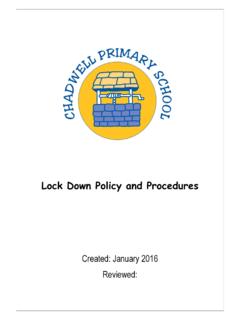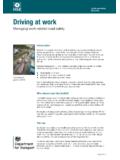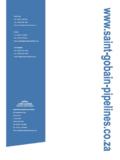Transcription of Offshore COSHH essentials - Health and Safety Executive
1 Health and Safety ExecutiveBreaking containment process cleaning operationsControl approach R Respiratory protective equipmentOCEO ffshore COSHH essentialsThis information will help Offshore dutyholders (owners, operators and contractors) to comply with the Control of Substances Hazardous to Health Regulations 2002 ( COSHH ), as amended, to protect workers guidance consolidates good control practice and reinforces existing knowledge with additional will help you carry out COSHH assessments, review existing assessments, deliver training and in supervising activities involving substances hazardous to is aimed at staff whose responsibilities include the management of substances hazardous to Health on Offshore installations (eg occupational Health specialists, COSHH assessors, supervisors etc).
2 It is also useful for trade union and employee Safety this guidance is not compulsory and you are free to take other action. But if you do follow this guidance, you will normally be doing enough to comply with the law. Health and Safety inspectors seek to secure compliance with the law and may refer to this guidance as illustrating good see essential information on the back of the this sheet covers This sheet describes good practice for internal cleaning of process plant and vessels, eg separators, hydrocyclones, pipework etc. It covers the key points you need to follow to help reduce exposure to an acceptable level, as part of your COSHH Process plants and vessels may contain condensate crude oil and gas. Hydrocarbons can include BTEX (benzene, toluene, ethylbenzene and xylenes) Health risks include cancer, genetic damage, reproduction effects, and sensitisation by inhalation or skin The workplace exposure limit (WEL) for benzene is 1 ppm (8-hour time-weighted average (TWA)).
3 Keep exposure as far below this as reasonably Hydrogen sulphide (H2S) may also be present in hydrocarbon process plant and vessels, particularly when reservoirs begin to mature and water out (see OCE6).3 Mercury may also be present in process plant and vessels (see OCE14).3 NORM (naturally occurring radioactive material) may also be present in process plant and vessels (see ORE1).Access3 Where possible, erect an enclosure or Erect barriers and and proceduresPlanning3 Define the isolation standards and routines for draining, purging and See sheet OCM1 if work is in a confined If NORM is present then ensure that your radiation protection supervisor (RPS) has written local rules for the job (see ORE1).3 See sheet OCE6 if H2S is See sheet OCE14 if mercury is equipment3 Where possible use alternative cleaning methods without breaking containment, eg sand washing containment process cleaning operations OCE13 Respiratory protective equipment3 Provide a spillage clean-up Provide for drainage to appropriate drains, eg closed Provide for gas venting to a safe place, eg a flare stack or cold Provide eyewash equipment and an emergency shower close to the work Provide enough fresh air to dilute and remove air Provide portable hydrocarbon detector in the Respiratory protective equipment is normallyControl procedures3 Isolate the line for safe Connect via valves and lock the pipework to the appropriate drain.
4 Purge and drain the Vent pressurised gases to a safe Prove isolation. Carry out pressure build-up (PBU) Drain, purge and flush the system to hazardous open Prove it is free of gas, if necessary have the authorised tester perform the gas Workers should break joints gently. In the event of an unexpected release, workers should evacuate the area immediately and raise the Fit Disturbed joint tags on broken Fit and leak-test blind flanges within 12 hours if the work is not Never allow pipe ends to remain Test for leakage on remaking the protective equipment (PPE) see OCM33 All PPE must be easy to decontaminate, eg Ensure that all items of PPE are protective equipment (RPE) see OCM43 Provide a filtering respirator or breathing apparatus, CE marked with an assigned protection factor of at least protective equipment3 Provide a slicker suit worn over boots, nitrile gloves, and a visor if the RPE does not have one.
5 Maintenance, examination and testingChecking and maintenance3 Make and follow schedules for preventative maintenance of plant and monitoring Before each use, check that portable monitors are fully charged and working Check for signs of damage to control equipment before starting Examine and test RPE thoroughly at least monthly and infrequently used RPE at least three monthly. Replace worn containment process cleaning operations OCE13 Respiratory protective equipment3 Check the airflow and air quality to air-fed RPE at least once every three months, or before use. Check in-line Ensure that breathable air compressors take in clean Keep records of all examinations and tests for at least five monitoring3 Monitor the air for benzene and H2S by meter, after Use personal monitoring results to decide if you need to carry out biological monitoring for Monitor to show that workers, PPE, equipment and areas are decontaminated to background levels of Provide radiation workers with personal dosimeters, changed once a and housekeeping3 Place a temporary bund to contain any Clear up small spills with inert absorbent pads.
6 Dispose as hazardous Wash all PPE and test to show that it has been Label bags of dirty clothing to warn the laundry about the Seek advice from the radiation protection advisor (RPA) for NORM Any waste discharged to the sea must comply with an environmental Drain liquid residues to appropriate drains through hoses and valve Residues are hazardous waste . Label containers clearly include a UN number where appropriate. Store and dispose of waste decontamination and skin care3 Provide warm water, mild skin cleansers, nailbrushes, and soft paper, fabric towels or hot air for drying. Avoid abrasive Tell workers to wash hands before every Provide pre-work skin creams that will make it easier to wash dirt from the skin, and after-work creams to replace skin : Barrier creams or liquid gloves do not provide a full surveillance3 Conduct low-level Health surveillance for dermatitis involving skin checks by suitably trained responsible Ask your RPA for help in deciding the workers classification for ionising radiation Radiation workers must be certified as fit to work with ionising Outside workers must have a radiation passbook.
7 Keep this up to checklist Is your radiation passbook up to date? Is the equipment in good condition and working properly? Is your portable/personal alarm fully charged and working properly? Is your respirator working properly? Check it every time. Look for signs of leaks, wear and damage before every job. Do you have a spill clean- up kit handy? If you find any problem, get it fixed. Don t just carry on working. Discard single-use gloves every time you take them off. Discard other gloves at the end of the shift. Wash hands before eating, drinking or using the by the Health and Safety Executive 03/11 Breaking containment process cleaning operations OCE13 Respiratory protective equipment Crown copyright 2011 This guidance was developed by representatives from the UK Offshore oil and gas industry and trade unions, with and supervision3 Provide supervision ensure that safe work procedures are Check that PPE use follows the local You need a trained Tell workers, including maintenance workers, what the hazards and risks Explain the dangers of Training includes toolbox talks on:n how to use equipment properly;n how to use the benzene monitor;n how to react to alarms and evacuate safely.
8 N how to use RPE and check that it is working;n how to clean up spills correctly; andn what to do if something goes Involve managers and supervisors in Health and Safety information OCE0 Advice for managers OCM1 Confined spaces OCM3 Personal protective equipment (PPE) OCM4 Respiratory protective equipment (RPE) OCE6 if hydrogen sulphide is present ORE1 if NORM is present OCE14 if mercury is presentOther legislation Radioactive Substances Act 1993 Other hazardsn Flammabilityn Hydrogen sulphide (H2S) n Mercuryn Substances harmful to the marine environmentFurther informationRespiratory protectiveequipment at work: A practicalguide HSG53 (Third edition)HSE Books 2005 ISBN 978 0 7176 2904 6 process safetyindicators: A step-by-step guidefor chemical and major hazardindustries HSG254 HSE Books2006 ISBN 978 0 7176 6180 exposure limits You can find the full OffshoreCOSHH essentials series

















